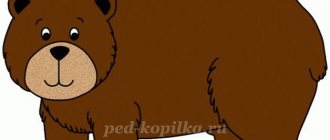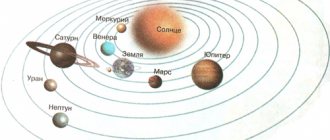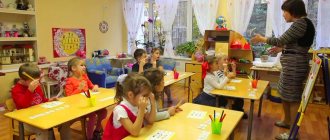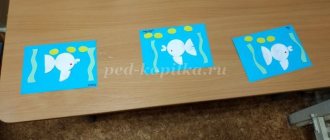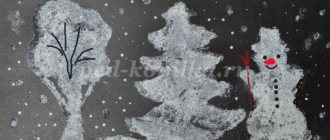Summary of the lesson on FEMP in the second junior group “Big - small”
Lyudmila Bylkova
Summary of the lesson on FEMP in the second junior group “Big - small”
Summary of a lesson on FEMP in the second junior group on the topic “ Big - small ”
Program content
Learn to distinguish objects by size: large - small ; focus on the size of objects, develop the ability to analyze, compare, and carry out sequential actions; cultivate cognitive interest in classes .
Didactic visual material
Demonstration material. Three bears, chairs, dishes, beds of different sizes, 3-4 large and small cubes , a large and small box .
Handout. Small and large cubes (3–4 pieces for each child)
.
Progress:
1 part. Three bears come to visit the children. The children, together with the teacher, remember which fairy tale they are from, look at them, find out that Mikhailo Potapovich is big and Mishutka is small . The teacher draws the children’s attention to the dishes, chairs and cribs: “Are they the same size? Show me the big chair . And now small, etc. d. Who will eat from a large dish and who from a small one ? For whom is the big bed , and for whom is the small bed ? Put the bears to sleep. Let's sing them a lullaby "Tired toys sleep"
.
Physical minute:
Three bears walked home Children waddle in place
Dad was big, big . Raise your arms above your head, pull up.
Mom is shorter with him, hands at chest level.
And my son is just a little baby. Sit down.
He was very , crouching and swinging like a bear.
He walked around with rattles. Stand up with your hands clenched into fists in front of your chest.
Ding-ding, ding-ding. Children imitate playing with rattles.
Part 2.
Game exercise “Let’s build turrets”
.
The teacher tells the children that the little bear doesn’t really like putting his toys away on the shelves and offers to help him. Large and small cubes are placed on the table , invites children to compare them by size, and then build towers. The teacher builds a tower from large cubes , and the children build towers from small cubes . At the end of the work, everyone looks at the buildings together, shows the big ( small )
tower.
They discover that there is a large and a small box , the teacher asks how they can be used, the children are asked to put the large cubes in the large box , and the small ones in the small one .
The teacher praises the children for helping Mishutka restore order. Mishutka rejoices and thanks everyone and promises that she will no longer scatter her toys.
Lesson summary for the 2nd junior group “Big-Small”, prepared by V.V. Shevchenko.
Topic: “Big - small. One, many, none. Grouping by color"
Goal : To teach children to combine identical (by color, size) objects into object sets according to a verbal task.
Continue to teach how to identify one object from many, answer the question “how many”? in words one, many, none.
Materials: soft toy Bunny. Demonstration cubes: large, small for the teacher and two cubes - large, small for each child, large and small box, red, blue, green and yellow plates, one piece per child. Circles of four colors: red, blue, yellow and green. One black circle for each table. Carrots according to the number of children.
Progress of the lesson.
- Motivational-orientation stage
-A forest animal decided to visit us today. Try to guess who came to us. He has long ears and a small tail. He loves to jump and loves to chew carrots.
-This is a bunny.
-Right! Our bunny loves to play and build towers: high and low. But I haven’t learned how to collect toys yet. And you and I are already big children, we have learned to play and put toys in their places. Let's help our bunny put the cubes into boxes.
- Search stage
The game is the task “Put the cubes into boxes.”
Cubes are laid out in front of the child: large and small for each child. Two boxes have been prepared: large and small.
-The bunny brought cubes for each of you and asks you to put them in boxes: large cubes in a large box, and small cubes in a small box.
-Look, what kind of box is this? (large).
-What is this box? (small).
Look at your cubes. Show me a big cube (show). Show me the small one (show).
On the teacher’s table there are demonstration cubes: large and small. The teacher is the first to lay out the boxes, accompanying the actions with speech.
-Look, I will put a large cube in a large box, and a small cube in a small box.
(children complete the task after the teacher explains).
.-So we helped Bunny: we put the big cubes in a large box, and the small ones in a small box. The bunny is happy, he smiles:
-How many cubes are in the boxes? (a lot of)
-How many cubes do you have? (no one).
3.Practical stage
Plates are laid out on the table. Each child has his own plate of a certain color: blue, red, yellow and green. In the center of the table there are multi-colored circles of red, yellow, blue, green and one black. Children should put circles in their plate that are the same color as the plate itself.
-Look at the colorful plates the Bunny brought for you. The Bunny also brought colorful circles and asks to put them on plates. What color is the plate, the same color of circles should be placed in it. Put red circles in a red plate, blue circles in a blue plate, green circles in a green plate, and yellow circles in a yellow plate.
Each child places the circles on their own plate (children complete the task independently). There should be a black circle left on the table.
- Said, what color are the circles in your plate? (blue). How many are there? (a lot of).
-Look, there is a circle left on the table. What colour is he? (black).
— How many black circles are left on the table? (one).
Physical exercise "Loud - quiet."
-Let's rest a little. Let's play the game "Loud - Quiet." When I play the tambourine loudly, loudly, you will jump like bunnies. And if I start ringing the bell quietly and quietly, you hide (squat down).
The game can be complicated by playing musical instruments without showing the children, giving them the opportunity to guess by ear.
Game-task “How many carrots”.
Carrots are displayed on the board according to the number of children.
-Our Bunny is so hardworking. He carefully prepared for winter. What do bunnies like to eat?
-Carrot.
- Right. How many carrots are there on the board? (a lot of).
-Come up and take one carrot at a time (children come up and take a carrot).
-How many carrots do you have, Artem? (one).
-How many carrots did you take? (one by one).
-Now put them on the table again. How many carrots do you have, Zhenya? (none).
-How many carrots are there on the board? (a lot of).
- 3. Reflective-evaluative stage
-It's time to say goodbye to our guest. Where does Bunny live, guys?
-In the forest.
-That's right, did you like playing with the Bunny? And he really liked you. He says that you are great! He promises that he will come visit us again soon. Goodbye, guys!
